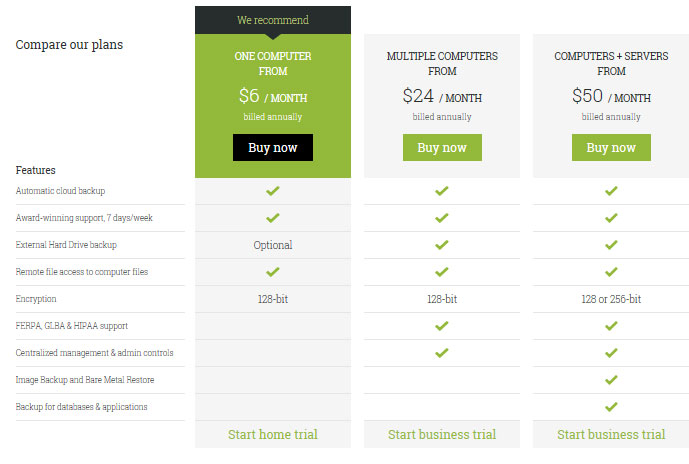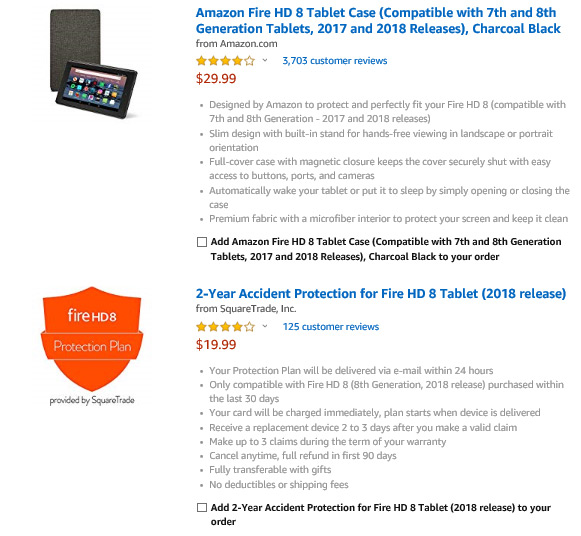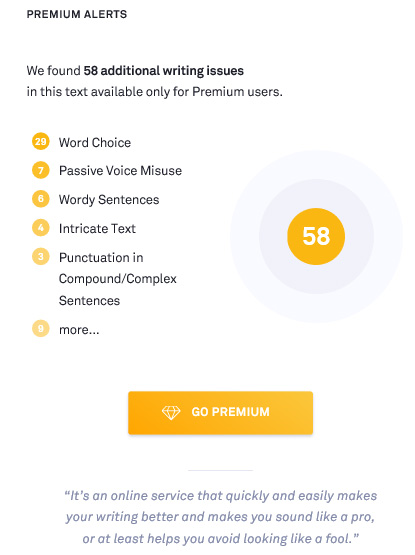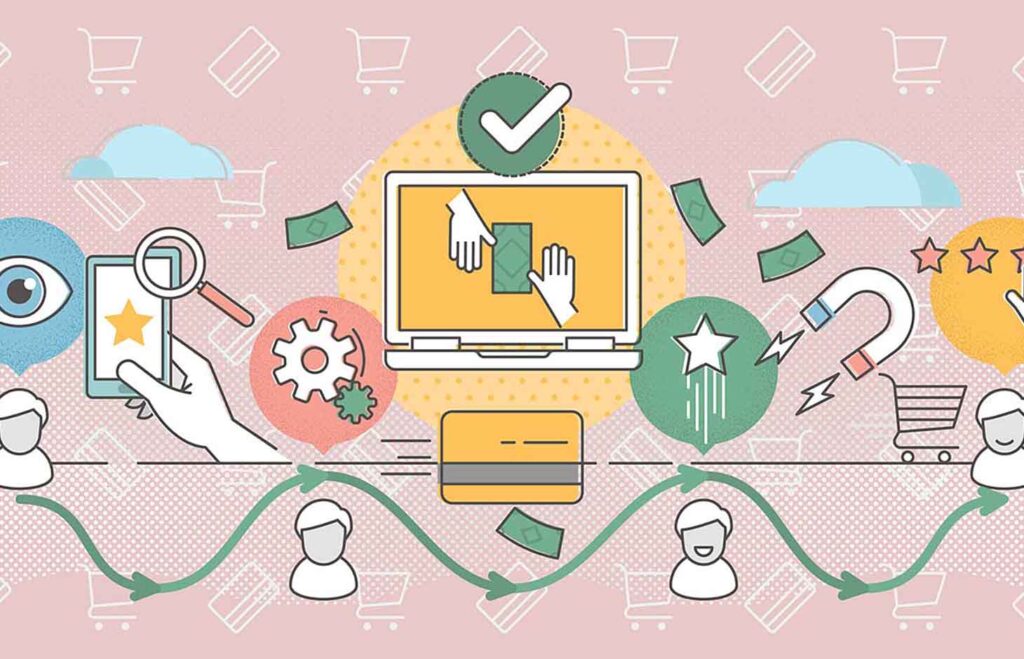In 2009, a lawsuit was filed on behalf of Carbonite—a SaaS business that provides data backup for customers ranging from individual PC owners to large companies. In the lawsuit, Carbonite—named after the substance that froze Han Solo in The Empire Strikes Back—alleged that hardware provider Promise Technology sold it over $3M in defective hardware which lost backup to more than 7,500 customers.
Regardless of who was at fault, lost backup in a data backup business could have been a death blow. However, Carbonite not only maintained its credibility, but also it has seen its stock grow by almost 175% in the past three years.
With those numbers, it’s obvious to see Carbonite has made some strong business decisions. One of those decisions was to leverage its product by buying other businesses, such as Mozy, and upselling to those customers. The company also offers discounts and pro-ration for as much as two months for early renewals.

Upgrade subscription plans, improve recurring revenue
Upselling is a strategic sales technique used to tempt customers to expand or upgrade their subscription plan with additional features, add-ons, etc. When done correctly, upselling strategies enhance value for a customer while also improving recurring revenue for a subscription-based business.
Let’s take the example of a telematics company that uses video and data recorders in fleet vehicles to analyze driver behavior. With the data captured, customers can analyze the way drivers perform in situations that impact safety and fleet operations.
With video telematics, there are several different ways to upsell. If the standard package offers 250 minutes of video, the business could upsell to 400 minutes for an incremental cost. Or, if a package covers 75 trucks, it can offer to cover other vehicle types, such as company vehicles for sales purposes.
Consider a company that has multiple purchasing packages. Upselling takes Package 1 and offers the addition of useful features from Package 2. The customer gets what they want from Package 1 with added features and for less than the total they would spend on both packages.
The revenue generated from single packages—with added features from another package—might be less than selling both packages at the same time. However, if selling both packages together is cost-prohibitive, you’re providing customers with an alternative that works for their budgets and your needs.
Not to be confused with price bundling or cross-selling, upselling targets existing customers who already know your product and understand its value.
In fact, statistics suggest the probability of selling to a current customer is 60 to 70% compared to 5 to 20% for a new customer. And with new customer acquisitions costing five times more than retaining a customer, it’s critical to offer existing customers new options.
When you purchase a Kindle from Amazon, for example, adding the device to your cart automatically generates a pop-up message such as this:

While upselling is a tried-and-true sales technique, this strategy is packed with potholes. You can run the risk of turning off your customers and losing them to the dreaded churn machine. Here are some techniques that may aggravate your customers, and should be avoided:
1. Insistent/aggressive sales tactics
Nobody wants to feel like they’re being bullied into making an upgrade to a purchase. There’s nothing wrong with telling a customer what other packages are available for purchase or upgrade. That is to say, there’s nothing wrong with telling them once. Two, three, or more prompts after a customer has already turned down the upgrade is simply going to make them mad. Maybe even mad enough to write a blog post about it, like this Tigerair customer.
If a customer is trying to complete a purchase online and they’re bombarded with different ‘offers’ while on the checkout page, they’re more likely to abandon the cart altogether. And with an estimated 69% of carts being abandoned online, a business certainly doesn’t want to add to this figure.
2. Not enough value
Businesses that don’t have the right balance between a product they’re trying to build upon and the additional features will inadvertently turn a customer off. Know what you’re offering. Ask yourself these questions:
a. Is my upsell affordable to customers?
If the additional features are too expensive, a customer is going to balk. For example, if your Package A is $25 and Package B is also $25, does it make sense to offer them an upgrade for $50 total, or should you offer the upgrade for $40?
b. Is my upsell cost effective for me?
In the drive to garner more revenue and make your customers happy, don’t undersell your additional features. Package A and B are both $25, but if it costs $20 to manufacture each product, charging $40 to upsell Package A with features from Package B is going to mean you only break even. You might have happy customers, but you’ll never turn a profit.
Lou Ellerton, Mash Strategy Studio’s associate director, has some great advice on the subject.
“You need to know what that value is in order to successfully build on it to cross-sell or upsell, and then leverage or reinforce it, not chip away at it,” he said. “By trying to sell something that’s not relevant to your customers, lacks credibility from you, or can be delivered better by someone else, you dilute your brand, what you’re known for, your expertise in your customers’ eyes, and you risk losing them.”
3. Sneaky Upsells
Sometimes, unscrupulous or careless businesses tie on their upsells to guarantee the success of a product. For example, in the early days of do-it-yourself website building, a customer could be thrilled to find out their new website would cost $29 per year.
As soon as the first payment was made, however, a dizzying number of upsell attempts muddied the waters—did the customer want to pay extra to guarantee their information was safe from potential hackers? What if they thought they were paying for unlimited pages, but found out that the price included unlimited content on three pages, unless they upgraded?
What could (and should) be a cut-and-dry interaction can easily be sullied with sneaky upsells. If a company has three pricing tiers, it should spell out what’s included (and not included), while other upgrades are clearly defined.
A business can easily turn a customer off by handling upsells poorly. Look at your offerings from your customer’s point of view. Does the upsell make sense? Is it hidden? Take care to ensure any limitations are spelled out during the initial sale to avoid customer dissatisfaction and churn down the road.
If you plan to upsell your product to your customer, it’s critical to provide a good balance between the upsell product and the additional money paid. If not, customers are apt to cry ‘fraud’ or ‘scam’.
These two words tossed around in online reviews and other social media outlets can erode even the most solid, well-meaning sales tactics.
How does a business avoid these pitfalls and use upselling methods effectively? Here are six tips to keep in mind when creating your business’s upsell policy.
1. Ask yourself
Is my pricing in line with the market? Before making any pricing change, it’s critical to take a look at past data. What are your customers willing to pay for each package? When you break out upgrade options, what might they be willing to pay?
A comprehensive billing platform can give a business the flexibility to test different pricing strategies, such as stairstep pricing, tiered pricing, and volume pricing. Even if a business dismisses a particular pricing approach, valuable data is gathered and stored.
With that information, the platform can provide a number of different reports so you can examine historic buyer preferences.
What are they willing to pay for? What prices detracted from your sales model?
Armed with this data, you can segment and identify different features a customer wants the most, and is willing to pay extra to utilize.
2. Show your customers a well-defined pricing strategy
A McKinsey report tells us that the largest e-commerce businesses generated $2.6B in 2016, up from $57M only five years prior, and that trend has continued exponentially since that time.
Consequently, consumers are better educated, more experienced in the e-commerce market, and keeping an eye out for signs they’re being misled by hidden prices. They want to know what they’re paying for. Even if your pricing is inadvertently generic, there’s going to be a wariness if customers don’t see clear-cut pricing for both general packages and upsells.
Now more than ever, it’s essential to demonstrate your transparency to customers.
If it’s difficult to put yourself in your customers’ shoes to see things from their perspective, your business and its customer success management (CSM) team needs to make this a primary goal. In fact, the CSM team can help with the upsell process, which brings us to the next point.
3. Time your upsells wisely
Successfully upselling to your customers often comes down to timing. When your customers are struggling with your product and opening support tickets for assistance, it’s not a good time to suggest adding another feature.
It’s wise to determine what type of CSM role your business should deploy.
a. Does your CSM methodology serve as a business advisor to your customers?
This type of CSM knows your customers and has an ongoing relationship with them. Your CSM knows their business objectives and goals and can make intelligent upsell suggestions to help them work toward those milestones.
b. A sales-oriented CSM has sales quotas to upsell to their existing customers.
Unlike a ‘bank teller’ CSM that tries to grow their market share, the sales-oriented CSM generally works with large enterprise customers, where market penetration can take many quarters or even years.
When a certain goal is reached with your customer, though, such as a triumphant implementation or helping them reach a significant milestone, ride the wave of success by suggesting an additional feature.
Cultivating a successful relationship with your customer and aligning the upsell with their future plans and goals is a great strategy to build on existing trust.
4. Back up your upsells with proof
Customers need to know your other features are going to provide true benefit. This is where touting positive reviews is critical. Survey your customers to gauge their feelings, and use their positive accounts on your website, communications, and social media outlets.
Put together some tangible, documentable data, such as: “93% of customers using Feature X report a higher ROI than those without it.” This will help generate additional interest in features or services a customer might benefit from, even if they didn’t previously know they existed or hadn’t seen the value in adding.
For example, editing software Grammarly offers a free version, but also provides tempting reasons why a user would benefit from purchasing its plan.

Customers use social proof to make decisions. Preparing your evidence and making that information visible gives your product the tangible credibility necessary to persuade customers to buy into other features.
5. Provide a free trial to try a new feature
Often, the best way to demonstrate the effectiveness of your product is to let customers take a test run of the new features when you roll them out. Offering a free trial period to play with additional features is going to demonstrate your confidence in the product while making sure it’s truly something that will fit their needs.
After all, it’s in everyone’s best interests to make sure the upsold features are something that will be beneficial. If customers aren’t interested in the features after trying them out, you still maintain a good relationship with the customer. And if they’re ready to make that additional purchase, they’ll go into the change feeling good about their decision.
6. Talk to your customer at all stages of the upsell strategy
Know their preferences, their needs, and their goals. If you’re giving your existing customer the opportunity to try a new feature or service for ‘free’, check in with them at the mid-point of a trial to make sure they don’t have any questions. Circle back again at the end of the period to see if they’re interested in adding that feature to their subscription.
This is where the CSM-customer relationship proves invaluable, because they already have an open line of communication and trust has been established.
If they’re not interested in the upsell feature, ask them why. This helps you uncover any opportunities to improve a feature or service, while also underscoring their importance to you.
Customers want to know they’re valued throughout their relationship with your business, not just immediately after the upsell process. Your word choice on invoicing and email communication will underscore their importance to your business.
Upselling isn’t always going to be successful, but keeping your product sticky and making sure to provide new innovative subscription features, enhancements, and features will continue to whet your customers’ appetites, keep them satisfied, and help increase their overall customer lifetime value.
Quick FAQs about Subscription Business
Q: What is upselling in the context of a subscription business?
Upselling in a subscription business involves encouraging existing customers to upgrade their current subscription plans by adding additional features or products. This strategy not only enhances the customer experience by offering more value but also increases the business’s recurring revenue.
Q: How did Carbonite leverage upselling to grow its business?
Carbonite successfully grew its business by acquiring other companies, such as Mozy, and upselling their services to these new customer bases. They offered discounts and prorated early renewals to incentivize customers to upgrade, contributing to a 175% increase in their stock over three years.
Q: What are some effective strategies for upselling subscription services?
Effective upselling strategies include offering incremental upgrades, such as additional features or increased service limits, creating package add-ons that enhance core offerings, and timing your upsell pitches strategically, such as after a customer success milestone.
Q: Why is upselling more profitable than acquiring new customers?
Upselling is generally more profitable because selling to existing customers has a higher success rate (60-70%) compared to new customers (5-20%). Additionally, acquiring new customers can cost five times more than retaining existing ones.
Q: What common mistakes should businesses avoid when upselling?
Common upselling mistakes include being overly aggressive with sales pitches, confusing customers with too many simultaneous offers, and failing to clearly communicate the value of the upsell. It’s crucial to respect customer decisions and avoid pressuring them into upgrades.
Q: How can businesses ensure their upsell offers are well-received?
Businesses can ensure their upsell offers are well-received by ensuring the additional cost is justified by clear value, aligning offers with customer needs, and maintaining transparent communication about what each package includes.
Q: What role does customer success management (CSM) play in upselling?
Customer success management plays a crucial role in upselling by building strong relationships with customers, understanding their goals, and suggesting relevant upsell opportunities that align with their needs and achievements.
Q: How can upselling contribute to customer satisfaction and retention?
When done correctly, upselling can enhance customer satisfaction by providing solutions that better meet their needs. Offering trial periods for new features and ensuring that upsells genuinely add value can increase customer retention and loyalty.
Q: What is the difference between upselling and cross-selling in subscription businesses?
Upselling involves encouraging customers to purchase a higher tier of service or additional features within their current subscription. In contrast, cross-selling suggests complementary products or services that the customer might find valuable alongside their existing subscription.
Q: How can businesses use social proof to enhance their upselling strategy?
Businesses can leverage social proof by showcasing positive customer testimonials and data demonstrating the benefits of upgraded features. For instance, sharing statistics like “93% of customers using Feature X report a higher ROI” can effectively persuade customers to consider upselling options.







